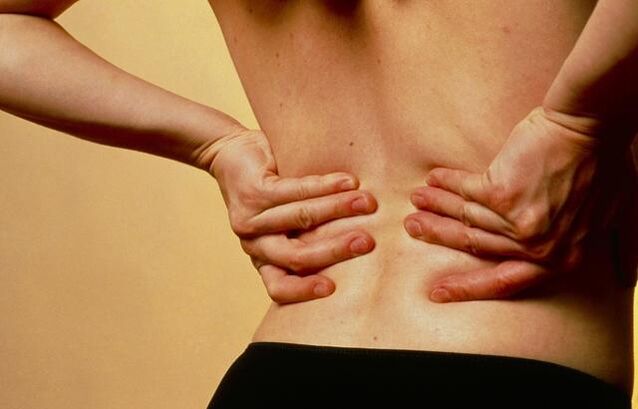
According to world statistics, about 80% of the adult inhabitants of our vast planet are united by the same health problems — periodic, even recurring, lower back pain. Low back pain is a major symptom of many diseases of the spine and internal organs located in the abdominal cavity. Most people who feel sick in this area, bypassing the doctor, without understanding the cause, start to apply various creams and other "home lotions" intensively, which is completely futile. Using these methods, you can easily achieve the opposite of what you expected.
Reason: Confirmed, Excluded
The success of any treatment depends directly on the accuracy of the diagnosis, and as sensory symptoms resolve, the likelihood of recurrence increases. Subsequently, such treatment can only make the situation worse. So, first of all, you need to carefully check the condition of all your organs, the symptoms of which may be lower back pain.
digestive system
Exacerbation of digestive diseases (pancreatitis, ulcers, colitis, cholecystitis, enteritis, appendicitis) often causes the appearance of lower back pain.

urinary system
Most of the time, kidney pain is mistaken for a symptom of lumbar spine disease because they are the same in nature. Diseases of the kidneys and urinary tract of various etiologies are accompanied not only by "recoil" in the waist, but also by urination disturbances (increased frequency, discomfort, appearance of blood in the urine and its cloudiness), and body temperature.
reproductive system
Pain usually radiates to the lower back, coccyx, or side due to problems with the reproductive organs in both men and women in the acute phase. The nature of these pains is usually a girdle with no obvious positioning.
If any organ disease unrelated to the musculoskeletal system is detected, treat him as he is the real cause of the pain syndrome. If a thorough examination reveals no problems with the above-mentioned organs, it is likely that there is a problem with the spine.
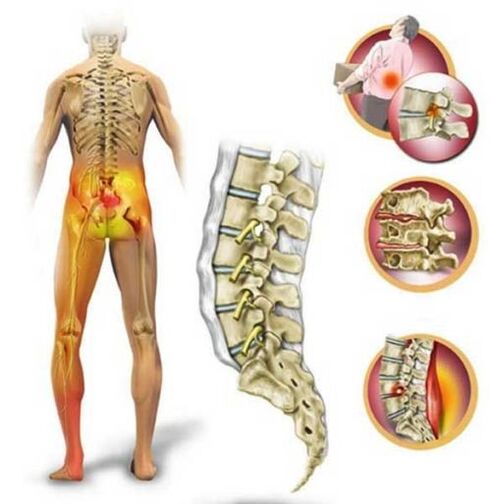
osteochondrosis
The most mobile part of the spine that carries most of the load is the lumbosacral region. Osteochondrosis develops degenerative dystrophic changes in the intervertebral cartilage in the lumbar region due to a sedentary lifestyle, excessive stress and insufficient nutritional intake by the cartilage tissue of the spine.
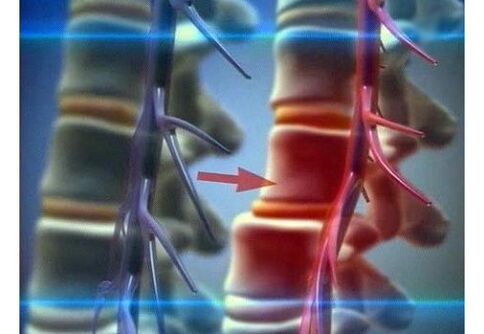
Symptoms and stages of disease
The main worrying symptom of osteochondrosis is lower back pain. In the initial stage, it is positioned and directed towards the sacrum, which is characterized by a pull (pain). During this time, the destruction process affects the nucleus pulposus (dehydration occurs) as well as the intervertebral discs (their standing height decreases). Uncomfortable with heavy loads, the pain itself is mild.
After a while, ignoring the problem and doing nothing will start shooting in the thighs and buttocks. The spine becomes unstable due to the narrowing of the intervertebral space and the "sagging" of muscles and ligaments. This can lead to loss of sensation and numbness.
The third stage is characterized by changes in the morphology of the intervertebral disc, severe deformation of the spine itself, and the development of disc herniation and prolapse. Pain at this stage becomes more intense and persistent. Every movement brings unbearable pain. Because the annulus fibrosus herniates and affects the spinal canal, it can squeeze the spinal cord, blood vessels, and areas of nerve endings near the site of pain.
The final stage of lumbar osteochondrosis "forces" the body to adapt to the changes that occur due to the disease in the following ways. To maintain support and protection, bone tissue grows in the diseased area. This often results in various microtraumas, which then lead to disability.
Comprehensive treatment approach
Treatment of lumbar osteochondrosis must be comprehensive, regardless of the stage of development of the disease. The form is mild, the prognosis of treatment is good, and the deformation process can be stopped completely with minimal consequences. In the final stages of the development of the disease, the task of treatment is to eliminate all symptoms and consequences, normalize the nutrition of the spinal tissues, strengthen the muscles of the entire back and its lower corset.
drug
To reduce the pain of lumbar osteochondrosis, analgesics are used in tablets or injections, the second option is more effective because it is more potent. To relieve the inflammatory process, anti-inflammatory drugs (non-steroidal) are prescribed. Muscle relaxants eliminate muscle spasms that go hand in hand with pain. Chondroprotective agents are used to restore damaged cartilage tissue.
All of these remedies sometimes don't have the desired effect because the damage prevents the drug from penetrating the site of action.
Blockade is used to relieve acute attacks of pain. Only experts can perform it.
A suitable analgesic is injected into the space between the spinous processes using a long needle. After such an operation, the pain disappeared quickly, but for a while, because there was no treatment effect.
Effective use of topical complex means - ointment, gel. They have analgesic, anti-inflammatory, warming properties, and many topical preparations contain chondroprotective agents. These treatments are very effective when used correctly and combined with massage.
Physical Therapy Program
Combined with medical treatment of lumbar osteochondrosis, physical therapy procedures are used - balneotherapy, laser and magnetic therapy, weak current, light and vibration therapy. They have virtually no side effects and contraindications.
alternative method
More and more alternative (non-traditional) methods are used alongside traditional treatments - leech therapy, acupuncture, bee stings, manual therapy. These methods can give people long-awaited relief, but some of them have contraindications that require consultation with the attending physician.
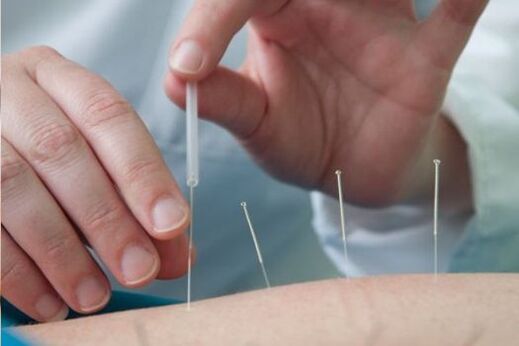
In addition to all the treatments mentioned above, physical therapy also helps to overcome the disease. Appropriate distribution of the load of the required intensity will help restore circulation to the damaged area, forming or strengthening the muscular corset, thereby reducing the load on the spine.
In the treatment of osteochondrosis, it is important to combine the correct treatment, first with relief of acute pain attacks, then with inflammatory processes, and only when the acute phase of the disease is over, non-traditional methods and physical exercise. used.
The yoga and Pilates complex has proven to be very suitable as a rehabilitation program for spinal disorders.
lumbar hernia
In the context of insufficient or neglected treatment of osteochondrosis in the lumbar region, hernias often occur - a disease that, due to insufficient physical activity or overload, occurs in the nutrition of the disc tissue, its strength is reduced, and, as a result, the disc ruptures. The process of destruction can drag on for years, going unnoticed, but with just one unsuccessful move, the mechanism kicks in and all the symptoms start showing up one after the other.
General symptoms and course of disease
Symptoms of a lumbar hernia include diminished tendon reflexes, pain of varying intensity, muscle weakness, and numbness in the extremities. The pain of a hernia doesn't always happen, it is possible for back pain to spread gradually in the direction of the pinched nerve.
Body deformation is a characteristic sign of a lumbar hernia. This phenomenon occurs involuntarily as the body needs to find the most comfortable position with the least pain. In severe, rapidly progressive disease, the consequence may be paralysis (partial or complete) of the lower extremities. This phenomenon is often accompanied by disturbances in the function of abdominal organs, especially the bowel and bladder.
Clinical manifestations of a lumbosacral hernia are increasing and intensifying pain during specific physical activity (lifting weights, bending over, intense muscle tension, coughing), dull pain, localized pain going away, pain in the direction of the hip or leg, or numbness in the area.
Diagnosis of lumbar hernia
It is difficult to diagnose a hernia with the naked eye or just by the symptoms described by the patient. To more accurately determine the presence of disease, several methods are used that help pinpoint the location of the disease. Computed Tomography, MRI, and Radiography - Thanks to these methods, doctors will be able to visually locate the diseased vertebra and see the deformed disc.
To determine the severity and consequences of the disease, doctors use several tests: raising the straight leg, tendon reflexes, sensitivity (response) at all levels of the leg (from the toes to the hip) to several types of stimuli -Pain, vibration and temperature.
treatment method
Different hernia treatments are used depending on the severity and condition of the patient. If the condition worsens, the first must immediately limit exercise activities until bed rest, and pain relief with drugs. After 5-7 days, when the acute phase is over and the pain subsides, drug therapy is supplemented with other restorative procedures (massage, physiotherapy, sports).
Medications and conservative treatment for lumbar hernia are the same as for osteochondrosis.
Operation
In severe cases with many serious consequences, surgery is recommended.
Indications for surgery:
- Hernia isolation - a portion of the disc damaged by the hernia enters the spinal canal;
- Dysfunction of all or one organ in the pelvis;
- Impaired spinal patency (as determined by MRI);
- No results for three months or more with medical and conservative treatments;
- Inflammation of the sciatic nerve.
Surgical treatment of hernias is now performed with the help of sparing, minimally invasive endoscopic surgery.
The method of laser reconstruction involves the use of a laser to evaporate fluid from the protruding nucleus pulposus. Because of this, the nerve root is "liberated", that is, its compression is removed. But there are many contraindications to this type of intervention, these are early surgery of the spine, spondylolisthesis, spondyloarthritis, impaired patency (stenosis) of the spinal canal and herniation of the nucleus pulposus into the canal.
To remove the damaged portion of the disc, the method of percutaneous discectomy is used. Evaporation and removal of damaged tissue is performed with a needle that passes through the skin.
In cases where the damaged disc cannot be repaired by any means, starting with medication and ending with minimally invasive surgery, or all methods used have had no effect, the deformed disc is replaced with a prosthesis.
Precaution
To prevent the progression of the disease, special exercises are prescribed. Exercise complexes should be developed individually for each patient by a specialist and must include exercises for muscle stretching, tension, and light aerobic exercise.
For lumbar hernias, doctors recommend wearing special straps. From the outside, it looks like a capsule, it is about 30 cm wide and fastened to the body with Velcro, with several degrees of rigidity.
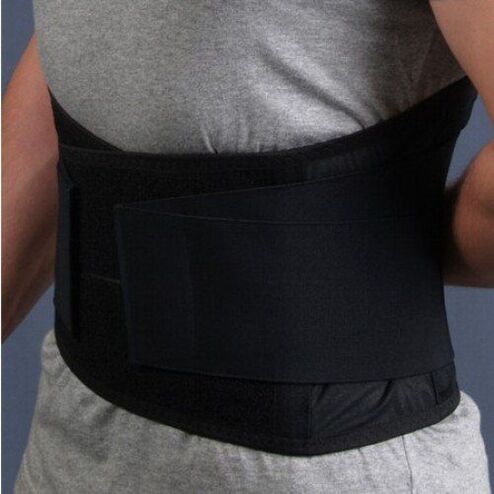
This product is required for even distribution of load (from diseased to healthy areas) and stress relief (unloading). The injured part of the spine that is constantly wearing the seat belt is corrected and returned to its anatomical position.
Low back pain with radiculopathy
As a result, on the background of lumbar osteochondrosis and hernia, low back pain develops - low back pain (acute paroxysmal pain). This is the "simplest" scenario. Because hernias and osteochondrosis are characterized by deformity of the damaged disc and frequent prolapse and spinal displacement, nearby nerve roots are invaded, a condition known as radiculopathy.
It magnifies by encroaching on the veins, which causes tissue edema (softness) and congestion. Symptoms of low back pain with radiculopathy are similar to those of lumbar hernia (acute shooting pain radiating downward, loss of sensitivity, and impaired reflexes), and since this is the result, the cause must first be treated with a comprehensive approach, otherwise disabilitythreaten.
sciatica
Another consequence of hernias and osteochondrosis is inflammation of the sciatic nerve - sciatica and accompanying pain that radiates to the legs or buttocks. Although it is possible to clearly define where "pain" is, the cause is in the spine.
Sciatica is not a disease on its own, the term refers to some of the symptoms that accompany certain spinal disorders. Pain can feel different, in some cases it's just mild discomfort when held in the same uncomfortable position for a long time, and sometimes the pain can lead to loss of consciousness, in which case pain relievers won't help.
For effective treatment, just diagnosing sciatica or low back pain is not enough; in any case, a comprehensive examination by various experts is needed to accurately identify the cause, because it is the triggering factor. As only some symptoms are eliminated, the potential for underlying disease progression and many complications increases. Taking care of your health, identifying problems early and treating them promptly is the key to staying healthy.
















